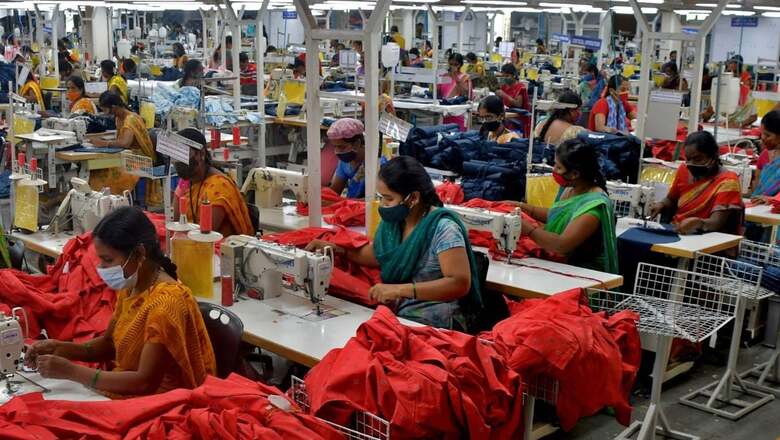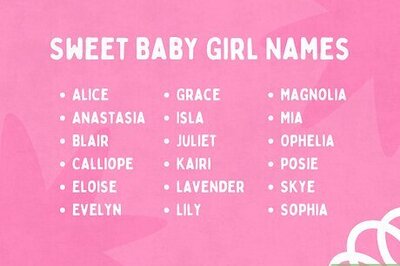
views
Bharat Tex 2024, India’s premier global textile event, is set to witness a grand confluence of iconic handloom and handicraft traditions from Gujarat, Maharashtra, Telangana, Uttar Pradesh, and Madhya Pradesh. Remember, Bharat Tex is set to be the world’s biggest textile expo. Five Indian states and exhibitors from across the country are set to showcase their textile strengths at the event, as India aims to take its diverse textile heritage around the world.
Set to be inaugurated by Prime Minister Narendra Modi on February 26, Bharat Tex will witness various states and exhibitors displaying their shared artistic excellence, featuring handloom craftsmanship, and unveiling distinctive textile innovations. The event will have more than 3,500 exhibitors and over 3,000 overseas buyers participating. Over 40,000 visitors from more than 40 countries are expected to attend.
With Uttar Pradesh and Maharashtra coming on board as ‘Partner States’, Bharat Tex will also witness the participation of Gujarat, Telangana and Madhya Pradesh as ‘Supporting Partner States’. Andhra Pradesh, Tamil Nadu, Karnataka and Assam are also setting up state pavilions at the mega textile event.
From Madhya Pradesh’s iconic Batik printing, hand-block printing, Chanderi and Maheshwari silk; Gujarat’s Bandhani, Patola silk, hand-painting; Uttar Pradesh’s Chikankari, Zari-Zardozi; Maharashtra’s Paithani saree, Warli Art, Mashru & Himroo to Andhra Pradesh’s much-admired Jute, hand-drawn Kalamkari, lavish handwoven Dharmavaram sarees and fine Mangalagiri cotton weaves, Bharat Tex will boast globally acclaimed handicraft and handloom traditions from all parts of India.
Also on display will be the states’ progressive initiatives in terms of policies and innovative technologies like the upcoming textile parks. Essentially, it is not just the global textile market that India aims to dominate. India also wants the world to learn about how its textile industry functions and what goes on behind the making of world-famous handicrafts and apparel.
Participation from leading international textile companies, including H&M, Fortum, Lenzing, Busana Group and Hyosung Corp highlights India’s expanding influence in the global textile sector, indicating a favourable prospect for heightened investments in the nation’s textile industry. Aditya Birla Group, Reliance Group, Arvind Fashion, Welspun Living, Indorama Ventures, Trident Group, PDS and Shahi, Chargeurs PPC (France) will also participate in the expo. Besides industry participation, ministerial and business delegations are also expected from key textile hubs, including Australia, Italy, Turkey, South Korea, Bangladesh, Russia, Peru, Egypt, and Thailand.
While the collaborations represent a substantial stride towards advancing growth, innovation, and sustainability within the textile industry, the event itself will have over 50 knowledge sessions, where the exhibitors and an impressive mix of companies will showcase apparel, home furnishings, floor coverings, fibres, yarns, threads, fabrics, printing techniques, carpets, silk, textiles based handicrafts, technical textiles and much more.
Bharat Tex is poised to be a comprehensive showcase of the textile industry value chain, right from India’s rich cultural heritage and textile traditions to the latest technological innovations that are helping the country dream big and eye global markets.
States Optimistic as India Eyes Title of Global Textile Hub
Chief ministers from the participating states have shared their optimism about the event and how it can propel not just the rise of their local industry, but the Indian textile juggernaut on the global stage as a whole.
Chief Minister of Maharashtra, Eknath Shinde said, “Maharashtra has been a significant part of the growth story of the textile and apparel sector in India; be it the rich cultural tradition of the Paithani saree or the advancement of Smart Textiles by a few aspiring startups. The textile and technical textile sectors play a significant role in shaping Maharashtra’s economic landscape, and we are committed to nurturing its continued success. Maharashtra will ensure that every thread spun adds to the rich tapestry of our nation’s progress, towards a Viksit Bharat in 2047.”
Shinde’s counterpart from Gujarat, Bhupendra Patel said, “For Gujarat, textile is not just an industry, but also a tradition and a legacy which we present to the world through the magic of our handicrafts and machines. The growth of the textiles sector lies in the growth of India and the growth of job opportunities. Today, Gujarat has become a centre of attraction for the importers of garments across the globe. Gujarat is the highest contributing state in woven fibre production across the nation, reflecting our ambition to become a leader in ‘Make in India’ and ‘Make for the World’.”
Future of India’s Textile Industry Promising if Lingering Challenges Are Addressed
Bharat Tex is seen as the government’s big move to revitalise the Indian textile industry and push it towards doubling its contribution to the national GDP to 5 per cent by 2030. Getting more countries to import textiles from India will be a prime focus during the mega expo next month, as India looks to overcome the challenges faced by the industry by ensuring more international exposure for it.
Despite considerable challenges, the market for Indian textiles and apparel manufacturers is expected to double by 2030. According to a report by FICCI-Wazir Advisors, the textile market size is projected to grow at a 10 per cent CAGR to reach $350 billion by 2030. The IEBF report is a bit more promising, as it pegs the CAGR of the textile and apparel market at close to 15 per cent. It also estimates that the textile market size will grow to $387.3 billion by 2028.
Meanwhile, the Modi government’s PLI scheme for the textile sector is expected to bring in fresh investment of more than Rs 19,000 crore over the next five years, helping it achieve a cumulative turnover of over Rs 3 lakh crore and creating about 7.5 lakh direct employment opportunities.
While Bharat Tex is a mega event set to showcase India’s textile prowess before the world, the domestic industry itself is going through a tough phase, primarily due to the influx of Chinese goods that are cheap and create a disadvantageous climate for Indian manufacturers. Valued at over $150 billion, India’s textile industry is taking a hit as China dumps its man-made fibre (MMF) fabrics in India at relatively lower prices.
Importantly, the textile sector is the second-largest employer after agriculture, with 45 million people directly working in the sector and another 100 million depending on it from allied sectors. Wages for the people working in the sector are falling, forcing many to look at alternative employment opportunities.
In its quest of becoming a global textile hub, India anticipates tackling the sector’s challenges through increased exports and enhanced capital inflows. In this endeavour, Bharat Tex emerges as a pivotal player, poised to champion the global recognition of Indian textile craftsmanship. Positioned as the world’s largest textile expo, Bharat Tex is primed to catalyse the international appeal of Indian textile forms.
Views expressed in the above piece are personal and solely that of the author. They do not necessarily reflect News18’s views.
















Comments
0 comment